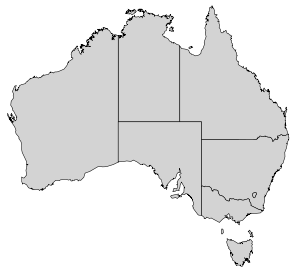- Yuin–Kuric languages
-
Yuin–Kuric Geographic
distribution:New South Wales, ACT, and SE Queensland, Australia Linguistic classification: Pama–Nyungan - Yuin–Kuric
Subdivisions: YuinKuriYoraThe Yuin–Kuric languages are a group of indigenous Australian languages within the Pama–Nyungan family.[1] These languages are divided into the Yuin, Kuri, and Yora subgroups,[2] although exact classifications vary between researchers. Yuin–Kuric languages were spoken by the original inhabitants of what are now the cities of Sydney and Canberra, as well as surrounding areas. Most of the Yuin–Kuric languages are now extinct.
The koala is named from the word gula for the animal in Dharuk,[3] a Yuin–Kuri language within the Yora subgroup, and the same word occurs in other Yuin–Kuri languages, such as Gundungurra,[4] within the Yuin subgroup.
Contents
Yuin subgroup
The Yuin subgroup includes:[2]
- Gundungurra, Gundungura, Gudungura, or Gandangara language, spoken by the Gandangara people in south-eastern New South Wales.
- Ngarigo or Ngarigu languages, including the Ngunnawal language, spoken by the Ngunnawal people in what is now Canberra and the surrounding Australian Capital Territory.
- Tharawal or Dharawal languages, extinct languages[5] spoken along the South Coast of New South Wales, including Geawegal/Gweagal, Thurga/Dhurga, Thaua/Thawa, and Dyirringany/Dyirringanj.
Kuri subgroup
- Yugambal or Yugambeh language, an extinct language spoken by the Yugambeh Bundjalung people living on the South-East Queensland coast between the Logan River and the Tweed River.[6]
- Ugarapul (Yuggera, Yuggarapul, and Yuggarabul)
Older classifications also included the following,[2] which have since been split off as two additional branches of Pama–Nyungan:[7]
- Worimi
- Awabakal language, spoken around Lake Macquarie in New South Wales. Awabakal was studied by Reverend Lancelot Edward Threlkeld from 1825 until his death in 1859, assisted by Biraban, the tribal leader, and parts of the Bible were translated into the language. For example, the Gospel of Mark begins: "Kurrikuri ta unni Evanelia Jesu úmba Krist koba, Yenal ta noa Eloi úmba."[8] The language is currently in early stages of revival.
- Gadjang, Gadang, Gadhang, Kattang, or Worimi language, an extinct language[5] spoken by the Worimi people, from the eastern Port Stephens and Great Lakes regions of coastal New South Wales.
- Dyangadi
- Anaiwan or Nganyaywana language, an extinct language from northeastern New South Wales.[5]
- Dhanggatti, Daingatti, Djangadi, Dyangadi, Thangatti, or Dunghutti language, a language from northeastern New South Wales (some researchers also include Nganyaywana here[9]).
Yora subgroup
The Yora (or Iyora) subgroup is sometimes divided among the other two subgroups. Spoken in the region of Sydney, it is sometimes defined to include the Awabakal language[5] listed above, as well as:[2]
- Darkinjung or Darkinyung language, an extinct language.[5]
- Dharug, Dharuk, Daruk, or Darug language, an extinct language[5] which attempts are being made to revive.[10]
Comparison
Jeremy Steele's partial reconstruction of the Sydney language[11] includes a comparison of pronouns in several Yuin–Kuric languages. The following partial and simplified version shows some of the similarities and differences across the family:
Language Group I You (singular) He We two (inclusive) We two (exclusive) We all (inclusive) Gundungurra Yuin gula-ngGa, gula-nga gulandyi dhanaladhu gulanga gulangala(ng) gulanyan, gulambanya(n) Tharawal Yuin ngayagang(ga) nyindigang namarang ngulgang ngangaling(ga) nyulgang(ga) Awabakal Kuri ngaduwa nginduwa nyuwuwa bali balinuwa ngiyin Darkinjung Yora ngaya nyindi, ngindi nuwa ngaliya ngungaliya ngiyang Dharuk Yora ngaya nyindi, ngindi nanu ngali — — Alternate views
As noted above, some researchers subdivide the Yuin–Kuric languages differently from others, and several languages of the Kuri subgroup have been otherwise classified within the Pama–Nyungan family.
Australian linguist R. M. W. Dixon rejects the concept of Pama–Nyungan languages completely, and indeed questions the traditional "family-tree" model of linguistic change. Dixon's classification does not include the Yuin–Kuric languages as a category.[12] Dixon presents a geographically-based classification, which has considerable overlap with the three subgroups Yuin, Kuri, and Yora:
Classification above Dixon[12] Yuin P: Southern New South Wales group Ngarigo languages Pa: Southern tablelands group (with Pa2 = Ngarigo and Pa1 = Ngunnawal) Gundungurra included in Pa1 Tharawal languages Pb: New South Wales south coast group (with Pb1 = Tharawal, Pb2 = Dhurga, Pb3 = Dyirringanj, and Pb4 = Thawa) Kuri N: Central New South Wales group Awabakal and Gadjang/Worimi Na: Awabagal/Gadjang subgroup (with Na1 = Awabakal and Nb2 = Gadjang/Worimi) Djangadi and Anaiwan/Nganyaywana Nb: Djangadi/Nganyaywana subgroup (with Nb1 = Djangadi and Nb2 = Anaiwan/Nganyaywana) Yugambal not included here (part of M: Central east coast group) no equivalent Nc: Central inland New South Wales subgroup (Wiradhuric languages) Yora O: Sydney subgroup Dharuk O1: Dharuk Darkinjung O2: Darkinjung References
- ^ AIATSIS Language and Peoples Thesaurus, accessed 23 Jan 2010.
- ^ a b c d Merritt Ruhlen, A Guide to the World's Languages: Classification, Stanford University Press, 1991, p 363, ISBN 0804718946.
- ^ Dixon, R.M.W.; Moore, Bruce; Ramson, W. S.; Thomas, Mandy (2006). Australian Aboriginal Words in English: Their Origin and Meaning (2nd ed.). South Melbourne: Oxford University Press. p. 64. ISBN 0-19-554073-5.
- ^ Eugene Stockton, Blue Mountains Dreaming: The Aboriginal Heritage, Three Sisters Productions, 1993, p. 88, ISBN 0646148834.
- ^ a b c d e f Christopher Moseley, Encyclopedia of the World's Endangered Languages, Routledge, 2007, ISBN 070071197X.
- ^ Yugambeh Museum web site introduction, web site by the Kombumerri Aboriginal Corporation for Culture, accessed 23 Jan 2010.
- ^ Ethnologue: Awabakal
- ^ Awaba electronic database: Language, accessed 26 Jan 2010.
- ^ Ethnologue: Nganyaywana
- ^ See the William Dawes web site, accessed 23 Jan 2010.
- ^ Jeremy Steele's Master of Arts thesis, 2005
- ^ a b R. M. W. Dixon, Australian Languages: Their Nature and Development, Cambridge University Press, 2002, pp. xxxiv–xxxv, ISBN 0521473780.
External links
- MultiTree language tree visualisation for Yuin–Kuric (O'Grady, Voegelin, & Voegelin, 1966)
- MultiTree language tree visualisation for Yuin–Kuric (Ruhlen, 1991)
- Indigenous Language Map
Languages of Australia English varieties 
Major indigenous
languagesArrernte · Kala Lagaw Ya · Luritja · Pintupi · Pitjantjatjara · Tiwi · Walmajarri · Warlpiri · Western Desert · Yolŋu MathaPidgins, creoles and
mixed languagesSign languages Categories:- Yuin-Kuric languages
- Extinct languages of Australia
Wikimedia Foundation. 2010.


